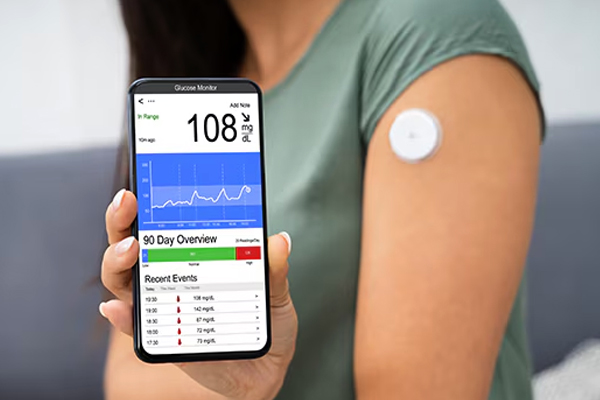Continuous Glucose Monitoring

Continuous Glucose Monitoring
What is Continuous Glucose Monitoring (CGM)?
Continuous Glucose Monitoring (CGM) is a method used to track blood glucose levels in real time throughout the day and night. Unlike traditional blood glucose meters that require finger-prick testing at specific intervals, CGM provides continuous, automated readings, offering a more comprehensive view of glucose levels and trends over time.
How Does CGM Work?
CGM systems consist of three main components:
- Sensor: A small, flexible sensor is inserted just beneath the skin, typically on the abdomen or arm. The sensor measures glucose levels in the interstitial fluid (the fluid between cells) and transmits data to the receiver or smartphone.
- Transmitter: The transmitter, attached to the sensor, wirelessly sends glucose readings to a compatible device, such as a monitor, smartphone, or insulin pump.
- Receiver/Display Device: This device receives and displays the glucose data, providing real-time glucose levels, trend arrows (indicating whether levels are rising or falling), and alerts for hypo- or hyperglycemia.
Key Features of CGM
- Real-Time Monitoring: CGM systems provide continuous updates on glucose levels, allowing users to see how their glucose responds to food, activity, stress, and medication.
- Trend Analysis: Users can view glucose trends over time, helping to identify patterns that may affect their diabetes management, such as the impact of specific foods or exercise routines.
- Alerts and Alarms: Most CGM systems include customizable alerts for high or low glucose levels, helping users take action before reaching critical levels.
Benefits of Continuous Glucose Monitoring
- Improved Glucose Control: By providing detailed insights into glucose levels, CGM enables individuals with diabetes to make more informed decisions about diet, activity, and medication, ultimately leading to better glycemic control.
- Reduced Hypoglycemia Risk: CGM alerts can warn users of impending low blood sugar, allowing for timely intervention and reducing the risk of severe hypoglycemic events.
- Increased Flexibility: CGM users often experience greater freedom in managing their diabetes, as they can monitor their glucose levels without frequent finger pricks, which can be painful and inconvenient.
- Enhanced Understanding of Glucose Variability: Continuous data helps users understand how their bodies respond to various factors, aiding in personalized diabetes management.
- Better Quality of Life: With improved control and fewer low blood sugar episodes, individuals using CGM report an enhanced quality of life and reduced diabetes-related anxiety.
Who Can Benefit from CGM?
CGM is suitable for individuals with type 1 diabetes and those with type 2 diabetes who require insulin therapy or have difficulty managing their blood glucose levels with traditional monitoring methods. It may also be beneficial for pregnant women with gestational diabetes or individuals experiencing frequent hypoglycemic episodes.
Limitations of CGM
While CGM offers many advantages, there are some limitations to consider:
- Calibration: Some CGM systems require periodic calibration with finger-stick tests to ensure accuracy.
- Cost: CGM systems can be more expensive than traditional glucose monitoring, and insurance coverage may vary.
- Sensor Lifespan: Sensors typically need to be replaced every 7 to 14 days, depending on the device, which may be inconvenient for some users.
- Accuracy Variations: CGM readings can occasionally lag behind blood glucose changes, particularly during rapid fluctuations in glucose levels.